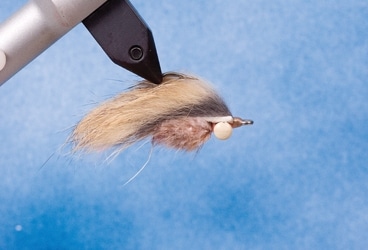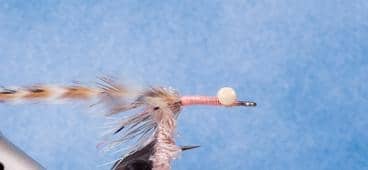
Blindcrabmain
Mole crabs (Emerita talpoida), also known as sand fleas, are common along the shorelines of oceans and bays throughout the Atlantic seaboard from Cape Cod to central Florida. These small, clawless olive-shaped crabs spend most of their time hiding in the sand right along the surf. Sometimes you’ll see them on the beach scurrying for cover, but distinctive ripples in the sand also indicate where colonies of crabs have buried themselves.
Opportunities to seize this prey are brief, so predators have to move slowly and focus intently to find and capture them. Presenting a fly to fish that are homed in on these unusual crabs creates a unique sight-casting situation. The most effective method is to get the fly well in front of the fish, allow the pattern to settle to the bottom, and then bring it to life with a short strip to attract the fish’s attention. Refrain from moving the fly too much – you want to make subtle hops and twitches interspersed with brief pauses, much like when bonefishing.
While there are several mole crab patterns, a recent Dave Skok adaptation of Bailey and Pallot’s classic Bonefish Bunny, which he calls the Blind Crab, is the best one I’ve fished yet. It’s a rabbit-fur fly that rides point up with a shock of rubber legs out the tail, and it has proven itself on many Northeast flats and beaches.
| Last September I had a chance to fish the infamous flat adjacent to the Oak Bluffs ferryboat dock on Martha’s Vineyard. These “downtown stripers” have undoubtedly seen more lures and flies than I have, and since they have Sea World-like living conditions, local legend is that they are impossible to catch.A gallery of 25 onlookers gathered as I descended the stairs to the beach. I felt pressure – the heat of 50 eyes that had seen many cocky anglers embark on this march to modesty. It’s amazing what you’ll pull out of your fly box in moments like this – I went with Skok’s brand-new crab pattern, which was totally unproven at the time. That’s how much I respect him; he’s clearly one of the best saltwater tiers today. | MATERIALS****Hook: #1 Mustad Signature C68S SS Thread: Shell-pink flat-waxed nylon and tan 3/0 Monocord Eyes: Medium lead dumbbell eyes (can be painted tan, cream or orange) Tail: Bleached elk hair Legs: Size M cream Span-Flex, barred pale pink and black with permanent markers Underbody: One strand of tan E-Z Bug or Bill’s Woolly Bugger Marabou Chenille and a ginger variant (or other color) saddle hackle Carapace: Natural hare’s ear magnum- cut zonker strip Glue: Head cement |
As I stepped into the water I heard murmuring, snickers and a cranky-sounding, “You’ll never catch ’em, sonny.” I had a few choice words for that person, and after I took three 27-inch fish on successive presentations, those words were “Skok’s Blind Crab.”
**
Tying Instructions**
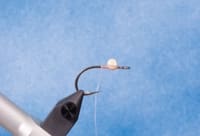
Step 1: Attach the eyes with the pink thread about 1/3 of the way down the shank, Clouser Deep Minnow-style on the top of the hook.
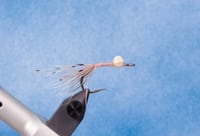
Step 2: Lay a base of thread down the length of the hook shank, then tie in a clump of bleached elk hair behind the eyes and wrap over the hair down the length of the shank and slightly down on the bend so that hair points up when the fly is inverted. The elk hair should extend at least 1/2 inch past the last thread wrap. After the elk hair, tie in four strands of premarked Span-Flex. These should be about as long as the elk hair, but trim the outside two strands slightly shorter than the center strands.
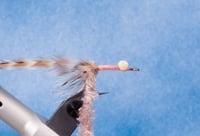
Step 3: Tie in about 4 inches of a single strand of tan E-Z Bug Chenille and a single thin-stemmed ginger saddle hackle at the bend.
****
**
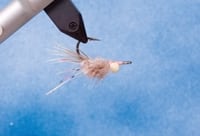
Step 4:** Wrap the chenille and the hackle together (bumblebee-style) all the way to the eyes. Do not wrap the chenille first and then attempt to palmer the hackle over it – the hackle stem will trap the strands of the fuzzy chenille and leave an unfinished appearance. Flip the fly over in the vise and trim the hook-point side of the materials flat. Whip-finish and apply head cement to the trimmed chenille/hackle and the exposed thread around the eyes.
**
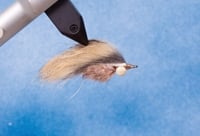
Step 5:** Start the tan thread in front of the eyes. Poke the hook point through the hide of the zonker strip so that the hair flows rearward and tie it in just in front of the eyes. Leave about 1/3 inch of hide hanging behind the bend. Pull the hide taut and trim it at the appropriate length. Cut off the square tips at the forward end, just behind the tie-in point, to help create a smooth, tapered head. Whip-finish and apply head cement.
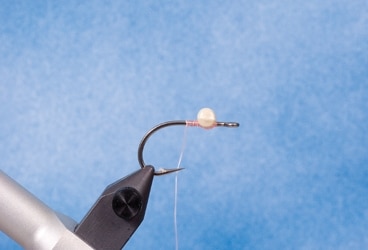
Tying Skok’s Blind Crab
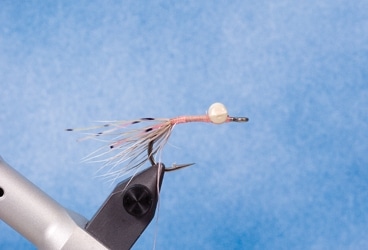
Tying Skok’s Blind Crab
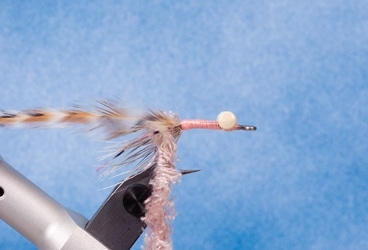
Tying Skok’s Blind Crab
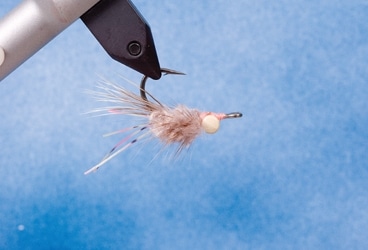
Tying Skok’s Blind Crab
